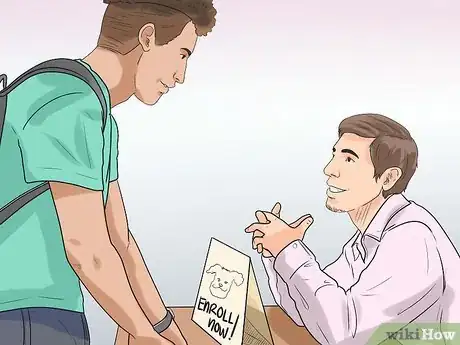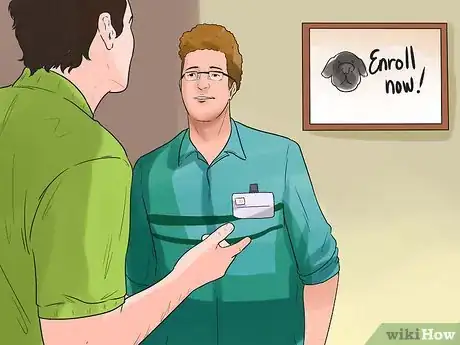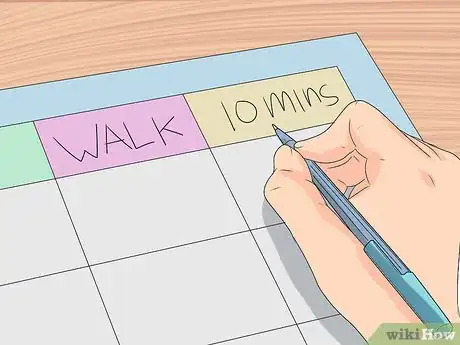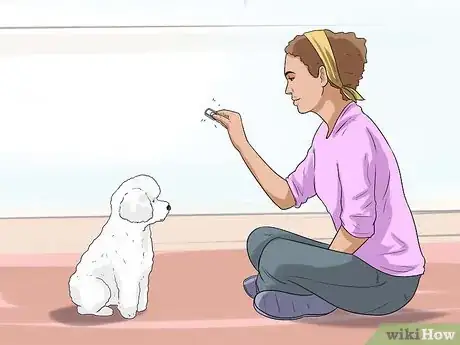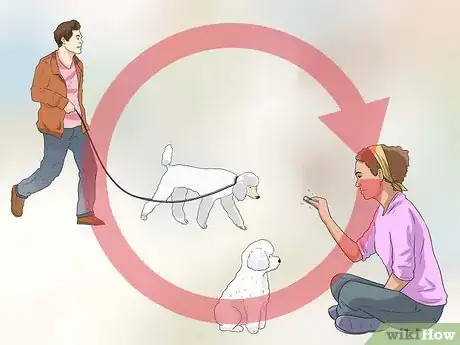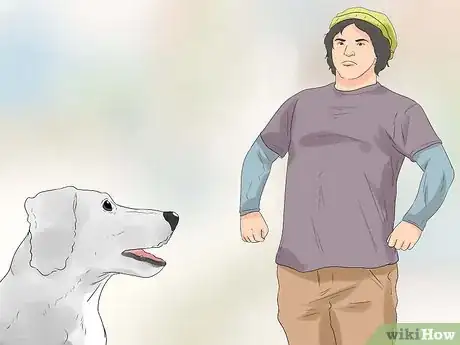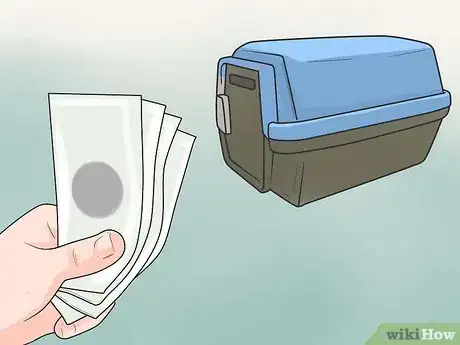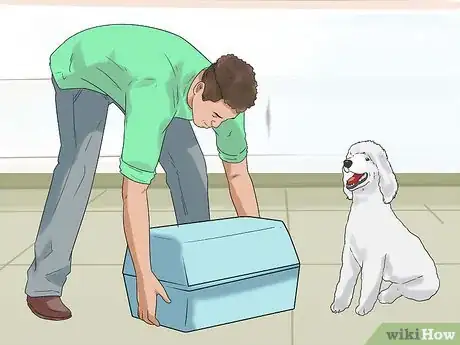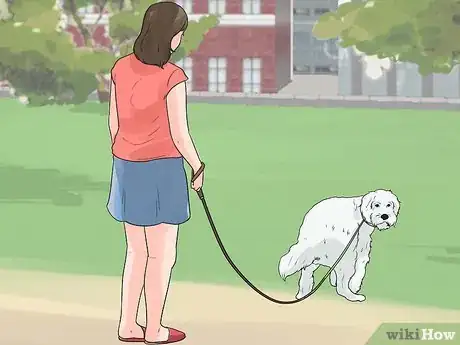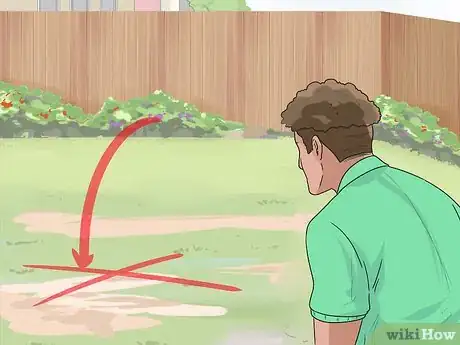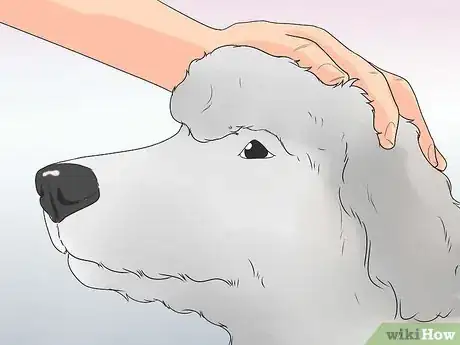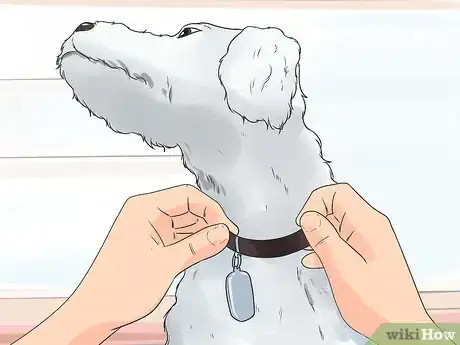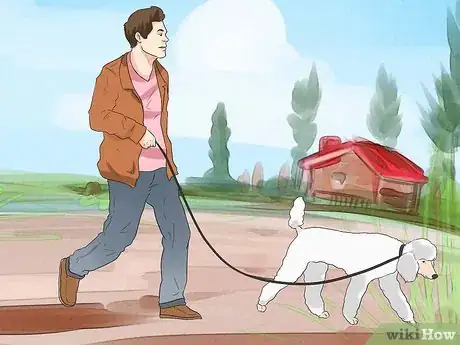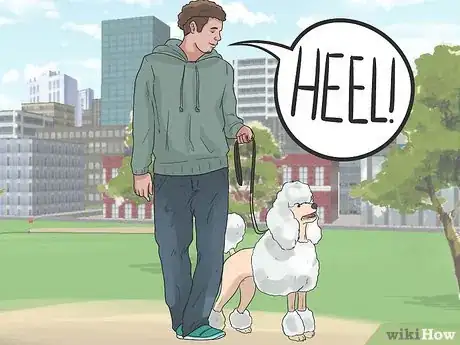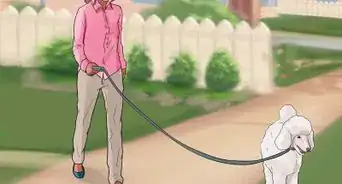This article was co-authored by Brian Bourquin, DVM. Brian Bourquin, better known as “Dr. B” to his clients, is a Veterinarian and the Owner of Boston Veterinary Clinic, a pet health care and veterinary clinic with three locations, South End/Bay Village, the Seaport, and Brookline, Massachusetts. Boston Veterinary Clinic specializes in primary veterinary care, including wellness and preventative care, sick and emergency care, soft-tissue surgery, dentistry. The clinic also provides specialty services in behavior, nutrition, and alternative pain management therapies using acupuncture, and therapeutic laser treatments. Boston Veterinary Clinic is an AAHA (American Animal Hospital Association) accredited hospital and Boston’s first Fear Free Certified Clinic. Brian has over 19 years of veterinary experience and earned his Doctor of Veterinary Medicine from Cornell University.
There are 16 references cited in this article, which can be found at the bottom of the page.
This article has been viewed 34,280 times.
Poodles make great pets. They are smart, active, and aim to please. But like all dogs, poodles need to be trained in order to be an ideal companion.[1] Despite having an outward appearance that looks somewhat prissy, poodles are also very athletic.[2] When it comes to training, your poodle might be a little stubborn, but, ultimately, he will want to work with you and please you. Be patient, and watch your poodle turn into a well behaved and loving companion.
Steps
General Training Tips for Poodles
-
1Enroll your poodle puppy in puppy kindergarten. If you have a puppy, enroll him in a puppy kindergarten class when he is about 8 to 12 weeks old. This timeframe is critical for proper puppy socialization. Puppy kindergarten will teach your poodle how to socialize with other dogs and other people, and be obedient in distracting situations. It will also help your Poodle become more self-confident.
- In addition to puppy kindergarten, socialize him on your own at home. Invite your friends over to expose your puppy to new people in a friendly environment. When you take him out on walks, introduce him to friendly neighbors and let him hear some of the sounds of everyday life, like cars passing on the street.
-
2Enroll your adult poodle in obedience class. Obedience class is where your poodle will learn basic commands, such as sit, stay, and heel. Your veterinarian or the staff at your local pet store can give you recommendations on quality obedience classes in your area.[3]
- Obedience class will not only teach your poodle basic commands, but will also teach him to see you as his leader.[4]
- Whichever commands you learn in class, practice these commands at home between classes.
Advertisement -
3Schedule short, daily training sessions. No matter how smart your poodle is, and how much he wants to please you, he will not want long training sessions. Limit your training sessions to 10 minutes. Any longer than that, and your Poodle may become bored.
- Make the training sessions fun to prevent boredom. For example, show lots of enthusiasm and give your poodle positive reinforcement. The more excited you are, the more he will enjoy the training sessions.
- Daily, consistent training will help you and your poodle develop a close bond. Since poodles enjoy working closely with their owners, your Poodle will likely enjoy working with you every day.[5]
-
4Practice one command at a time. When you teach your poodle basic commands, wait until he masters one before you move onto another.[6] If you try to teach multiple commands at once, your poodle may become confused with what you are trying to teach him, and he may become discouraged. Fully mastering one command will give him the self-confidence to learn even more.
-
5Keep your training consistent. Consistency is key when training a poodle. Continue to train your poodle throughout his life so he never forgets the commands. For example, when you teach him ‘sit’ as a puppy, continue to train him to ‘sit’ throughout his adult life and reward him each time he does so.
- You can also be consistent by giving the same command, in the same tone of voice, for a specific action.
- If you have other household members, make sure everyone uses the same commands so your poodle does not become confused with which command to follow. For example, if you say ‘stay,’ then other household members should not say something like ‘stay here.’
-
6Be firm during your training sessions. Do not let your poodle think he can get away with not following your commands. If he is getting impatient or fussy during a training session, end the session and pick up where you left off during the next session. Your poodle will learn that misbehaving during one training session does not mean he is off the hook for learning the command.
Crate Training a Poodle
-
1Purchase a crate. If your poodle is a puppy, it will be important to teach him how to stay in a crate. Choose a crate that will be large enough for him to stand up and move around in, but not so large that he can use a separate space to go to the bathroom. The crate should feel cozy to him, but not claustrophobic.[7] [8]
- A toy or miniature poodle’s crate should be 24 x 18 inches (61 x 46 cm) or 24 x 24 inches (61 x 61 cm). For a standard poodle, an ideal crate size is 48 x 36 inches (122 x 91 cm).
-
2Make the crate comfortable for your poodle. Crate training will go more smoothly if the crate looks inviting to your poodle. Place comfortable bedding in the crate that already has his scent on it. In addition, place some of his favorite toys in the crate, along with his food and water bowls.[9]
- Place the crate in an area close to people.[10] Since poodles love human companionship, having your Poodle’s crate in area with a lot of human activity will help him feel more comfortable.
- Remember that the crate should be a place of comfort and peace, not punishment.
-
3Encourage your poodle to enter the crate. Over the course of crate training, you will practice leaving your poodle in the crate for increasingly longer periods. To begin, leave the crate door open and toss some treats inside. When your Poodle enters the crate to eat the treats, immediately give him verbal praise. Do not force him into the crate if he is hesitant—let him enter on his own time so he will not have a negative association with the crate.[11]
- Work up to feeding him his meals in the crate.[12]
- It may help to give your poodle a verbal command, such as ‘kennel,’ when you want him to enter the kennel. Immediately give him a treat when he enters the crate after your command. Being consistent will greatly help. Make a crate routine, set time each day to put you poodle in the crate and give a treat after, Start slowly for about five minutes and then build up over time to about two hours. This will take time. [13]
-
4Close the crate’s door and leave the room. When your poodle is comfortable entering his crate, start closing the door behind him. Begin by closing it only for a few seconds when he is inside, then opening it back up again. Next, close the crate’s door and leave the room, randomly coming back for short time periods. Over time, gradually increase the time you stay out of the room after closing the crate door.[14]
- Do not open the crate door if your poodle whines or fusses. Doing so will teach him a bad habit for getting attention.[15]
- Even as your puppy becomes comfortable with staying in the crate with the door closed, you should not leave him in there day and night. He will not be able to hold his bladder for that long, and he will start feeling lonely by not being able to interact with you.[16]
House Training a Poodle
-
1Begin house training early. Whether you have a puppy or an adult poodle, it is best to start house training him soon after bringing him home. The earlier you begin, the quicker your poodle will know the proper place to go to the bathroom. The longer you wait, the more ingrained bad bathroom habits can become, making house training that much harder.[17]
-
2Create a bathroom schedule for your poodle. Your poodle should know when it is time to go outside to use the bathroom. Since puppies cannot hold their bladders for very long, they will need to go out more frequently. Good times to take your puppy out are first thing in the morning, after playing, and after eating or drinking.[20]
- As a rule of thumb, puppies can hold their bladder for approximately 1 hour per month of age, up until 9 to 12 months.[21]
- As your puppy poodle ages, wait for longer periods before taking him out after different activities. This will strengthen his bladder muscles.[22]
- Adult dogs can hold their bladders for longer, but should still be on a bathroom schedule.
- Keep the schedule consistent to decrease the chance of accidents in the house.
-
3Select an outdoor bathroom area for your poodle. Your poodle should go to the bathroom in the same place every time he goes outside. This will help him remember where he should go. If you have a backyard, choose an area that is away from areas where people would go (e.g., children’s play area, garden). The area should also be away from potential distractions, such as a busy street.[23]
- If you have a puppy and are not able to take him out several times a day, consider setting up an indoor bathroom area near his crate. Put some puppy pee pads down so he can relieve himself when you are not home. As he gets older and can hold his bladder for longer, discontinue using the pee pads.[24]
- If you do not have a yard, pick a nearby grassy area.
-
4Allow your poodle to pick the exact bathroom spot. Although you should identify the general area where your poodle should go, allow him to pick the exact spot within that area. When you take him outside, let him sniff around and explore within the general area until he settles on a specific spot.[25] After he picks the spot and relieves himself, take him to that specific area each time you take him outside.
-
5Wait for your poodle to eliminate. It may be tempting to give your poodle only a few minutes to go to the bathroom before you bring him in, especially if you are in a rush. However, rushing your Poodle when he is outside will not be very effective for house training—he may hold it so he can spend more time with you inside, increasing the chances of him having an accident.
- Ideally, you should give your poodle about 15 to 20 minutes outside.[26]
-
6Reward good bathroom behavior and ignore bad bathroom behavior. As you house train your poodle, reward him with positive reinforcement (e.g., verbal praise, extra petting) when he eliminates outside.[27] However, if he has an accident, do not punish him. Punishing him will make him fearful of you and make house training more difficult.[28]
- If he has an accident, clean it up without making a fuss. Use an enzymatic cleaner that will remove the odor so your poodle will not go back to that same spot.[29]
- If you catch him in the act of having an accident, interrupt him with a firm verbal command (e.g., ‘outside!’), pick him up, and take him outside to his designated bathroom spot. When he finishes eliminating outside, give him verbal praise and a treat.[30]
Leash Training Your Poodle
-
1Acclimate your poodle to a leash and collar. As with other forms of training, it can be easy to train your poodle puppy to walk on a leash. First, he will need to get used to the leash and collar. Place the collar on him and let him wear it while he is eating and doing other activities around the house. He may try to wriggle it off, but do not take it off him until he has settled down.
- Use a plain, flat collar. It should be snug around his neck (snug enough to stick 1 or 2 fingers between his fur and the collar), but not tight.
- Use a non-extendable leash that is 4 to 6 feet (1.2 to 1.8 meters) long.[31]
- To acclimate your puppy to the leash, attach the leash to the collar and let him walk around like that inside your home. Keep a close eye on him so he doesn’t entangle himself in the leash.[32]
-
2Take short walks with your poodle. When your poodle puppy is comfortable with the leash and collar, take him on short walks inside your home. Hold the leash loosely and give him lots of verbal praise during the walk. If he begins to pull, stop immediately—if you continue walking, he will think it’s okay for him to pull and strain on the leash.
- When he behaves well on the leash inside, start taking him on short walks outside.
- Gradually increase the lengths of the walks as your puppy becomes more comfortable with walking on the leash.
-
3Teach your poodle to heel. When you begin to leash train your poodle, it is okay for him to walk slightly in front of you. As the training progresses, though, he should learn how to walk beside you. The ‘heel’ command instructs your poodle how to do this.
- With your poodle standing on your left side, hold a squeaky toy or treat in your right hand. Allow him to see the toy, say ‘heel,’ and begin walking forward.[33] Give him a reward (the toy or a treat) when he can walk beside you for 20 to 30 seconds.
Expert Q&A
-
QuestionAre poodles easy to train?
 Brian Bourquin, DVMBrian Bourquin, better known as “Dr. B” to his clients, is a Veterinarian and the Owner of Boston Veterinary Clinic, a pet health care and veterinary clinic with three locations, South End/Bay Village, the Seaport, and Brookline, Massachusetts. Boston Veterinary Clinic specializes in primary veterinary care, including wellness and preventative care, sick and emergency care, soft-tissue surgery, dentistry. The clinic also provides specialty services in behavior, nutrition, and alternative pain management therapies using acupuncture, and therapeutic laser treatments. Boston Veterinary Clinic is an AAHA (American Animal Hospital Association) accredited hospital and Boston’s first Fear Free Certified Clinic. Brian has over 19 years of veterinary experience and earned his Doctor of Veterinary Medicine from Cornell University.
Brian Bourquin, DVMBrian Bourquin, better known as “Dr. B” to his clients, is a Veterinarian and the Owner of Boston Veterinary Clinic, a pet health care and veterinary clinic with three locations, South End/Bay Village, the Seaport, and Brookline, Massachusetts. Boston Veterinary Clinic specializes in primary veterinary care, including wellness and preventative care, sick and emergency care, soft-tissue surgery, dentistry. The clinic also provides specialty services in behavior, nutrition, and alternative pain management therapies using acupuncture, and therapeutic laser treatments. Boston Veterinary Clinic is an AAHA (American Animal Hospital Association) accredited hospital and Boston’s first Fear Free Certified Clinic. Brian has over 19 years of veterinary experience and earned his Doctor of Veterinary Medicine from Cornell University.
Veterinarian They can be easier to train if you reward them when they behave. Give your dog its favorite treat every time it listens to you to help encourage good behavior.
They can be easier to train if you reward them when they behave. Give your dog its favorite treat every time it listens to you to help encourage good behavior. -
QuestionAre poodles stubborn?
 Pippa Elliott, MRCVSDr. Elliott, BVMS, MRCVS is a veterinarian with over 30 years of experience in veterinary surgery and companion animal practice. She graduated from the University of Glasgow in 1987 with a degree in veterinary medicine and surgery. She has worked at the same animal clinic in her hometown for over 20 years.
Pippa Elliott, MRCVSDr. Elliott, BVMS, MRCVS is a veterinarian with over 30 years of experience in veterinary surgery and companion animal practice. She graduated from the University of Glasgow in 1987 with a degree in veterinary medicine and surgery. She has worked at the same animal clinic in her hometown for over 20 years.
Veterinarian "Stubborn" and "poodle" are not two words that usually go in the same sentence together. Poodles are clever dogs and, provided you give the right motivation, are usually eager to learn and cooperate.
"Stubborn" and "poodle" are not two words that usually go in the same sentence together. Poodles are clever dogs and, provided you give the right motivation, are usually eager to learn and cooperate. -
QuestionAre poodles hard to train?
 Pippa Elliott, MRCVSDr. Elliott, BVMS, MRCVS is a veterinarian with over 30 years of experience in veterinary surgery and companion animal practice. She graduated from the University of Glasgow in 1987 with a degree in veterinary medicine and surgery. She has worked at the same animal clinic in her hometown for over 20 years.
Pippa Elliott, MRCVSDr. Elliott, BVMS, MRCVS is a veterinarian with over 30 years of experience in veterinary surgery and companion animal practice. She graduated from the University of Glasgow in 1987 with a degree in veterinary medicine and surgery. She has worked at the same animal clinic in her hometown for over 20 years.
Veterinarian Poodles are highly intelligent and love the one-to-one attention that training offers. They learn quickly and are easy to train, provided you make things fun and use reward-based methods.
Poodles are highly intelligent and love the one-to-one attention that training offers. They learn quickly and are easy to train, provided you make things fun and use reward-based methods.
Warnings
- An untrained poodle may think he is alpha. This is more common with miniature and toy poodles, who tend to be more coddled than standard poodles.[35]⧼thumbs_response⧽
- Obedience training is necessary to keep your poodle mentally active. If he becomes bored, he may develop destructive behaviors. For very severe behavior problems, consult a professional dog trainer. [36]⧼thumbs_response⧽
References
- ↑ http://www.akc.org/dog-breeds/poodle/detail/
- ↑ http://www.justdogbreeds.com/poodle.html
- ↑ http://www.canismajor.com/dog/yobed.html
- ↑ http://dogtime.com/lifestyle/dog-activities/82-basic-commands-obedience
- ↑ http://www.akc.org/dog-breeds/poodle/detail/
- ↑ http://dogtime.com/lifestyle/dog-activities/82-basic-commands-obedience
- ↑ Brian Bourquin, DVM. Veterinarian. Expert Interview. 20 December 2019.
- ↑ http://petcareeducation.com/howtotrainadog/how-to-train-a-poodle/
- ↑ http://petcareeducation.com/howtotrainadog/how-to-train-a-poodle/
- ↑ http://www.humanesociety.org/animals/dogs/tips/crate_training.html
- ↑ http://www.humanesociety.org/animals/dogs/tips/crate_training.html
- ↑ http://www.petmd.com/dog/puppycenter/potty-training/evr_dg_crate_training_for_puppies#
- ↑ https://www.pbrc.net/crate-training.html
- ↑ https://www.pbrc.net/crate-training.html
- ↑ http://www.petmd.com/dog/puppycenter/potty-training/evr_dg_crate_training_for_puppies#
- ↑ http://www.humanesociety.org/animals/dogs/tips/crate_training.html
- ↑ http://www.allpoodleinfo.com/poodle-house-training
- ↑ http://www.justdogbreeds.com/poodle.html
- ↑ http://dogtime.com/dog-breeds/poodle
- ↑ http://www.humanesociety.org/animals/dogs/tips/housetraining_puppies.html
- ↑ http://www.akc.org/learn/akc-training/how-to-potty-train-a-puppy/
- ↑ http://www.allpoodleinfo.com/poodle-house-training
- ↑ http://www.allpoodleinfo.com/poodle-house-training
- ↑ http://www.akc.org/learn/akc-training/how-to-potty-train-a-puppy/
- ↑ http://www.allpoodleinfo.com/poodle-house-training
- ↑ http://www.allpoodleinfo.com/poodle-house-training
- ↑ Brian Bourquin, DVM. Veterinarian. Expert Interview. 20 December 2019.
- ↑ http://www.allpoodleinfo.com/poodle-house-training
- ↑ http://www.akc.org/learn/akc-training/how-to-potty-train-a-puppy/
- ↑ http://www.humanesociety.org/animals/dogs/tips/housetraining_puppies.html
- ↑ http://www.petexpertise.com/dog-training-article-training-your-dog-not-to-pull-on-the-leash.html
- ↑ http://www.animalplanet.com/pets/how-to-leash-train-your-active-puppy/
- ↑ https://www.akc.org/expert-advice/training/puppy-training/teach-your-puppy-these-5-basic-commands/#heel
- ↑ http://www.justdogbreeds.com/poodle.html
- ↑ http://dogtime.com/dog-breeds/poodle
- ↑ http://dogtime.com/dog-breeds/poodle
About This Article
If you want to train your poodle, enroll it in puppy kindergarten or an obedience class to help it socialize and learn tricks. In addition, you should schedule short, fun, daily training sessions of about 10 minutes in length, where you have your poodle practice commands. Make sure to teach your poodle one trick at a time, since it could get confused if you try to teach it too many new things at once. You should also use positive reinforcement, like verbal praise and extra petting, instead of yelling or punishing, since this will just make it afraid of you. To ensure your poodle doesn't forget what it's learned, keep your training sessions repetitive and your tone of voice consistent when you deliver certain commands. For more tips from our Veterinary co-author, like how to crate train your poodle, keep reading!
